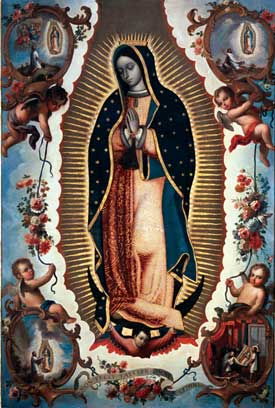Our Lady Of Guadalupe
 From Conservapedia
From Conservapedia 
Our Lady of Guadalupe (also called the Virgin of Guadalupe, Empress of the Americas, or The Brown Lady) is the name given to a series of five reported Marian apparitions as well as a venerated image on a cloak currently enshrined within the Basilica of Our Lady of Guadalupe in Mexico City. The Guadalupe apparitions are among the most famous of those approved by the Catholic Church.
The image associated with the apparitions, believed to have been given directly to the seer by Mary, is an important symbol of Mexico and Mexican identity, and is venerated by Roman Catholics all around the world.
Contents
- 1 The Apparitions
- 1.1 First Apparition
- 1.2 Second Apparition
- 1.3 Third Apparition
- 1.4 Fourth Apparition
- 1.5 Fifth Apparition
- 2 The Image
- 3 See also
- 4 External links
- 5 References
The Apparitions[edit]
First Apparition[edit]
According to tradition, Mary first appeared to indigenous Mexican Juan Diego (formerly Cuauhtlatoatzin) on December 9, 1531 at the Hill of Tepeyac as he was on his way to a Saturday morning mass at a nearby church.
Heavenly music filled the air as Mary appeared in a cloud, dressed like an Aztec princess and speaking in Diego’s own language. She identified herself and instructed that a chapel be built on the location of her appearance.
Second Apparition[edit]
After the first apparition, Juan Diego sought out the archbishop of Mexico City in order to inform him of what he had been told. The bishop was quick to reject Diego’s story, and Diego would go on to see Mary for a second time, telling him to keep insisting.
Third Apparition[edit]
On December 10, Diego spoke with the archbishop again, to which he was instructed to ask Mary for a physical sign of her appearance that can be accepted by the church. Diego then returned to Tepeyac and experienced the third apparition, in which Mary consented to provide something tangible on the following day.
Fourth Apparition[edit]
By December 11, Diego’s uncle Juan Bernardino had grown seriously ill, so Diego chose to tend to him rather than meet with Mary for a fourth time. On the following day, Bernardino’s condition had worsened to the point that Diego was ready to seek out a priest to minister to him on his deathbed. Though Diego set out on a different route in order to avoid Mary, he was intercepted by her and asked where he was going.
Upon Diego's admission, Mary gently rebuked him and assured him Bernardino had just made a full recovery. She instructed him to bring flowers from the top of Tepeyac hill (which was typically barren in the winter), where he would find non-native Castillan roses. Mary arranged the flowers in Diego's cloak, and upon Diego's returning to the bishop, the flowers fell from the cloak to reveal the image of Mary on the fabric.
Fifth Apparition[edit]
On December 13, the recovered Juan Bernardino described having also witnessed an apparition of Mary, and having been told by her to inform the bishop of what he had seen and that she desired to be known by the name "Guadalupe".
The Image[edit]
Currently enshrined at the Basilica of Our Lady of Guadalupe in Mexico City, the original image believed to have been given to Juan Diego by Mary is preserved behind glass above the altar. Many Catholic sources have attested to the cloak’s supernatural or miraculous qualities, such as:
- The fabric’s maintaining its structural integrity for nearly 500 years in spite of exposure to soot, candle wax, incense, and the fact that it was displayed for its first 115 years without any protective covering, while replicas are described as typically enduring for only around 15 years in similar conditions.
- The image repairing itself with no external assistance after an incident in which nitric acid was spilled on its top right in 1791.
- The image taking no damage from a November 14, 1921 secularist bomb attack, which damaged the altar of the basilica as well as other items, but did not affect the cloak.[1]
- Biochemist Richard Kuhn analyzed a sample of the fabric in 1936 and announced that the pigments used in the creation of the image come from no known earthly source, whether animal, mineral, vegetable, etc.
- An infrared light inspection by Dr. Philip Serna Callahan found that portions of the face, hands, robe, and mantle were painted in one step, with no visible corrections, sketches, or brush strokes.[2]
- Photographers in 1929 and 1951 claimed to have noticed a figure reflected in Mary’s eyes which tripled upon inspection in what is called the Purkinje effect (commonly observed in human eyes). Opthalmologist Jose Aste Tonsmann later enlarged an image of Mary’s eyes by 2500x and claimed to have found the aforementioned single figure as well as the images of others, variously believed to be either the witnesses present when the cloak was first revealed in 1531, or the images of a family - 13 or 14 people in all.[3]
See also[edit]
- Marian Apparition
- Jesus Christ
- Catholic Church
- Miguel Hidalgo
- Virgin Mary gallery
External links[edit]

- Basilica de Santa Maria de Guadalupe In Spanish.
- Our Lady of Guadalupe
- Our Lady of Guadalupe Smithsonian, The National Museum of American History.
- Iconos In Spanish.

References[edit]
- ↑ https://denvercatholic.org/lady-guadalupe-numbers/
- ↑ https://cruxnow.com/faith/2014/12/four-awesome-facts-about-our-lady-of-guadalupe/
- ↑ https://www.catholiceducation.org/en/culture/catholic-contributions/science-sees-what-mary-saw-from-juan-diegos-tilma.html
Categories: [Catholic Church]
↧ Download as ZWI file | Last modified: 03/04/2023 01:22:10 | 12 views
☰ Source: https://www.conservapedia.com/Our_Lady_of_Guadalupe | License: CC BY-SA 3.0
 ZWI signed:
ZWI signed: KSF
KSF